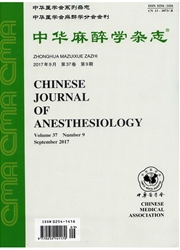

 中文摘要:
中文摘要:
目的探讨c-Jun氨基末端激酶(JNK)在全脑缺血再灌注大鼠海马神经元DNA修复中的作用。方法健康清洁级雄性SD大鼠108只,4月龄,体重290~310g,随机分为3组(n=36):假手术组(SH组)、缺血再灌注组(IR组)和JNK抑制剂SP600125组(SP组)。采用四血管结扎法建立大鼠全脑缺血再灌注模型,在夹闭双侧颈总动脉前30min,IR组侧脑室注射1%二甲基亚砜(DMSO)10μl,SP组给予SP600125(溶于1%DMSO,30g/L)10μl。SH组仅游离、暴露双侧颈总动脉,于上述相应时点给予1%DMSO 10μl。分别于再灌注2、6、12、24、48和72 h处死6只大鼠,测定海马CA1区中1/3段磷酸化JNK(p-JNK)和DNA修复蛋白X线修复交叉互补蛋白1(XRCC1)表达水平,观察神经元病理学结果及神经元凋亡情况。结果与SH组比较,IR组和SP组神经元凋亡指数升高,XRCC1表达下调,IR组p-JNK表达上调(P〈0.05或0.01),SP组差异无统计学意义(P〉0.05);与IR组比较,SP组神经元凋亡指数降低,p-JNK表达下调,XRCC1表达上调(P〈0.01)。结论JNK可使全脑缺血再灌注大鼠海马神经元DNA修复功能受损,导致细胞凋亡,其机制可能与下调DNA修复蛋白XRCC1的表达有关。
 英文摘要:
英文摘要:
Objective To investigate the role of c-Jun N-terminal kinases (JNK) on DNA repair in hippocampus after global cerebral ischemia/reperfusion (I/R).Methods One hundred and eight SD rats were randomly divided into 3 groups (n=36 each):groupⅠsham operation (SH);groupⅡischemia-reperfusion (I/R) and groupⅢJNK inhibitor SP600125 (SP).The global cerebral I/R was induced by four-vessel occlusion and maintained for 6 min.In SP group SP600125 30 g/L dissolved in 10μl of 1% DMSO was injected in the cerebral lateral ventricle 30 min before ischemia while in I/R group 1% DMSO 10μl was injected.Six rats each were killed at 2,6,12,24,48 and 72 h of reperfusion.The brains were removed for histological examination of hippocampal CA1 region.The number of apoptotic neurons in hippocampal CA1 region was counted by TUNEL and the expression of p-JNK and DNA repair protein X-ray repair cross complementing protein 1 (XRCC1) was detected by immuno-histochemistry.Results The number of apoptotic neurons was significantly higher and XRCC1 expression lower in I/R group and SP group than in SH group (P〈0.05 or 0.01).The p-JNK level was significantly higher in I/R group than in SH group (P〈0.05).The number of apoptotic neurons and the p-JNK level were significantly lower and the XRCC1 expression was significantly higher in SP group than in I/R group (P〈0.01). Conclusion JNK damages DNA repair function by down-regulating the expression of DNA repair protein XRCC1 during global cerebral I/R and induces neuronal apoptosis.
 同期刊论文项目
同期刊论文项目
 同项目期刊论文
同项目期刊论文
 期刊信息
期刊信息
